9th edition was a tale of gains and loss for the Necrons. Coming out as one of the earlier books, they suffered from what we like to call codex creep around this community, as the books that came in after them, showing a power that the first codex’s could not truly compete with. Though we will doubtfully see any kind of true acknowledgement of this fact, we can see it being reflected in the rules, gains, and changes that the army went through throughout the years. More specifically, every single model in its book gains the Core tag, instead of only about four different units.
With the introduction of the 10th edition, this is no longer the case. A world of a truly undead army stands before us, my friends, an army of robotic space zombies that are being shown in a way that is approachable for any kind of player. What may be off putting about this army is going to apply to the veterans who are used to reanimation protocols working a certain way. The way that this army plays is completely different than it was before. From reanimation protocols to quantum shielding, this army is presented in a way that is supposed to be focused on characters and characters being with units. This is of course reinforced by their new form of Command Protocols. What’s that? Well…let’s talk about Reanimation Protocols first.
Record scratch: Before we begin we’d like to thank Games Workshop for providing us with a review copy of the Index for review purposes.
Army Rule

Reanimation Protocols is a power Necron armies benefit from during the Command phase, in most cases. Each unit in the army with Reanimation Protocols activates the protocols and regenerates d3 wounds (prior to modification by any other effects).
If a unit contains models that have lost some of their starting wounds, one of those models is selected, and it regains a lost wound. This process occurs every time a unit reanimates a wound. On the other hand, if all models in a unit have their starting number of wounds but the unit is below its Starting Strength (i.e., missing models due to casualties), a destroyed model is returned to the unit with a single remaining wound. This is all very nicely explained by an example in the rule – you essentially keep adding wounds to the unit, including getting models back up, till you’ve used all of the roll. Notably, this means that Living Metal as a separate thing is gone – all models now have this, and it covers both bases.
Now, on paper this may sound a bit so-so – it’s not that many wounds, and like some implementations of Reanimation, it requires your unit to survive in order to benefit from it. However, there are enough ways to mess around with this mechanic that it ends up being pretty potent. The most important of these are Resurrection Orbs, the Reanimator and the Protocol of the Undying Legions stratagem. The first option lets your unit activate protocols in both player’s Command Phases, or in the case of the Command Barge pick one unit within 6” to do so in your opponent’s phase. The Reanimator massively boosts the effect in general – units within 12” reanimate an extra d3, which is a huge improvement (and if you combine it with an Orb, you get this in both turns). Finally, and crucially, the stratagem lets you trigger reanimation immediately after an enemy unit shoots your unit and kills at least one model, so if they’re trying to focus you down you can recover a clutch of wounds in between volleys, and benefit from any effects like the Reanimator or built-in unit capabilities at the same time.
Wings: This strat is incredible, especially once you bring Cryptothralls into the mix as we’ll get to, and in test games it’s been where the majority of my CP have ended up going.
All this means that this ability matters a lot now, and combined with better tools for making super tarpits and reduced lethality from some armies, it’s a big deal.
Detachment Rules
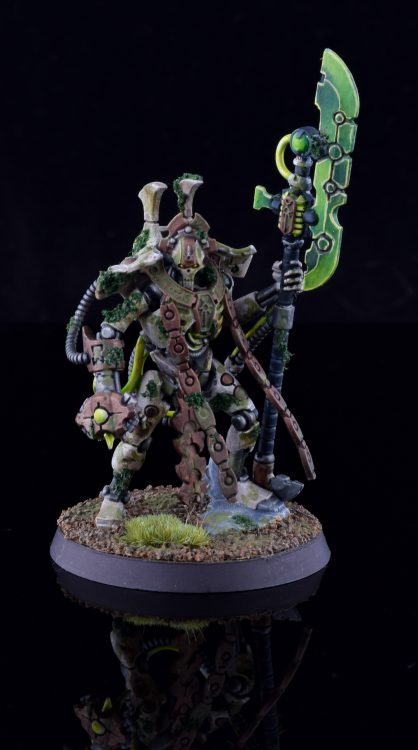
Detachment Ability
The detachment we are gifted is called the Awakened Dynasty. This provides us with the detachment ability Command Protocols.What this does is provide us with the template of how we may be looking at creating our army lists. While any Necrons Character is leading a unit, each time a model in this unit makes any attack they get +1 to the hit roll. Basically, as long as a character is leading a unit that unit will be hitting on 2s (or 3s for Warriors/Crypteks). Let’s sit with this for a second and just think about how many characters we have. From the powerful Overlord to all of our Cryptek options, we are encouraged to run plenty of characters or replacement bodies if Mr. Trayzen is on the table. Crypteks provide all sorts of different abilities you can bolt onto units, so this is basically a dream if you like tinkering with all sorts of configurations and setups, and just a great ability in general. It also has a weird impact on the Characters themselves, because they benefit from it too, so some weapons like the drawback where the theoretical downside is hitting on 3s get quite powerful.
Enhancements
The enhancements provided are pretty great, almost every single one is usable which isn’t the case for every index. Veil of Darkness makes a glorious return but acts a little bit differently. This Enhancement may only be used once every battle, at the end of your opponent’s turn, if the bearer’s unit is not within Engagement Range of any enemy units. Take that unit off the field of combat if it does. Set up that unit anywhere on the battlefield that is more than 9″ horizontally away from all opponent models during the Reinforcements step of your subsequent Movement phase. This is an ability I think we’ll end up seeing a lot through the index’s, but I feel a special place in a lot of Necron players’ hearts. It’s great for getting Lokhusts into position in particular.
Next is the one that we will be seeing on almost every table, the Sempiternal Weave. This is a simple, amazing upgrade that can be put on any Necron character that provides them with a 4+ Feel No Pain ability. This has a ton of applications for it, especially when we are taking into account the d3 minimum heal, and is particularly strong on the Command Barge
Before I go any further and with a little bit of a spoiler alert of what is coming up, I need to say one thing.
GW. Games Workshop. If you can hear me. Please do not allow these things to be taken on Transcendent C’tan. I’m not sure what you intended here, but you handled this already in 9th edition. Please save us from this monster.
We’re not done with the hits either – the next is great for building super durable deathballs, the Hypermaterial Ablator, providing Stealth to a unit and Cover in the open when shot from outside 12”. Stacking this on top of Lychguard -1 to wound is fun, giving you some real crunch. If you want to go completely the other direction and run a bunch of tanks, the final entry, the Sovereign Coronal, is what you’re after. This provides an aura that makes units count as being lead by a Character, allowing things where you can’t add any Leaders benefit from both Command Protocols and the boosted version of Stratagems. There are some pretty strong hulls available to Necrons now, and not every unit can embed Leaders, so this is a (very potent) way of unleashing their full potential.
All four of these should see plenty of use – great stuff.
Stratagems

Following in the theme of Necron units being led by characters and how that affects their output, we get to the Stratagems. The protocols that we were used to from the previous book, have all been turned into stratagems that do different interesting things that match their name – and pretty much all of them are good. They also all get better if a unit is lead by a Character (except for the Eternal Guardian), further reinforcing the detachment theme.
First up, Protocol of the Undying Legions, which we touched on above. For one command point, after our opponent has finished resolving a unit’s attacks, and as long as at least one Necron model in a unit died from them, we can then have one Necron unit from our army activate its Reanimation Protocols. If this unit is also led by a character, we will be healing D3 + 1 wounds. This is great on its own, but once you start adding in the Canoptek Reanimator and things like the Necron Warrior ability to reanimate d3+3 while on an objective, it gets wild Looking at the Necron Warriors that were shown on Warhammer Community, we can see that Necron Warriors who are standing on an objective near a reanimator are going to be bringing back 4+2d3 wounds, which is a bunch (and will often be used to get back Cryptothralls instead of Warriors).
The Protocol of Vengeful Stars also lets us do nasty things in the opponent’s shooting phase. After our opponent has finished attacking us, if they killed any models from the targeted unit, you get to shoot straight back for the low cost of 1 CP. If this unit is led by a character, you also get to Ignore Cover. This has a couple of key uses – it’s great with Lokhusts, and can be extremely strong if your opponent accidentally throws out a few shots to do some chip damage into a big brick of Warriors or Immortals and is Not Ready for what’s going to happen to them in response. It’s also a motivation to take units of three Lokhust Heavies – if your opponent shoots and kills one with a tank, there’s a legitimate chance of them just dying for their hubris. Classic Necrons. Also ultra nasty with Tesla Immortals buffed by a Plasmancer for Critical Hits on 5+. Love the smell of burning ozone.
In your own Shooting Phase, your tool for making things turbo-dead is Protocol of the Conquering Tyrant, giving you full wound re-rolls within half range for 1CP, or full range if you have a Leader. Six Lokhusts with a Lokhust Lord feels like a very good play in this index, and this is a major contributor. If you need to get into range to do that, Protocol of the Sudden Storm is the play, giving your unit’s weapons Assault, and letting them re-roll Advance rolls if they have a Leader. One of the few things that’s a downgrade for Necrons is that a few units are a little slower now (and have to abide by the new FLY rules), so this can be helpful for extra reach. If you instead want to kill something in the Fight Phase, use Protocol of the Hungry Void, giving +1 to S, and also improving AP by one if you have a Leader. It’s a mark of how good that these stratagems are that this might be the least flashy, but it’s still super good in the right situation, especially with reduced AP across the board.
Finally, standing back up has always been a key Necron trick, and their INFANTRY Characters can do it with Protocol of the Eternal Guardian, getting back up on half wounds. This is a little weird because unlike most versions of this effect, which trigger at end of phase, it happens immediately after you’re destroyed, so if you’ve been brutally overkilled by the enemy with loads of attacks still pending, it doesn’t necessarily do anything. The flip side of this is that most others have a failure case, whereas this just works, so if you’ve been sniped out by something with no more attacks to go, or the opponent pushes a kill on a crucial Cryptek with Precision, it can help. The other place it’s exceptionally good is on Illuminor Szeras, who is a complete nightmare to put in the ground, and is a 9W INFANTRY model. Great job pushing 9W through, now do another 5.
Wings: I have confirmed by doing this against Liam that opponents love this, and you should do it often.
Datasheets
Necrons have a surprisingly huge number of datasheets, coming from a combination of getting one of the last waves of resin Named Characters followed by two separate plastic kit overhauls. This gives you a whole bunch of options, and it’s going to take the points to really cement what works here. The option overload is particularly acute with Leaders that can join Warriors, Immortals or Lychguard, which is pretty much all the non-Destroyer ones. Furthering that, Crypteks can join a unit as a second Leader as long as the first is a Noble or a Royal Warden, providing an incredible suite of possible combinations. Let’s try and unpack that as we start with Characters.
Characters
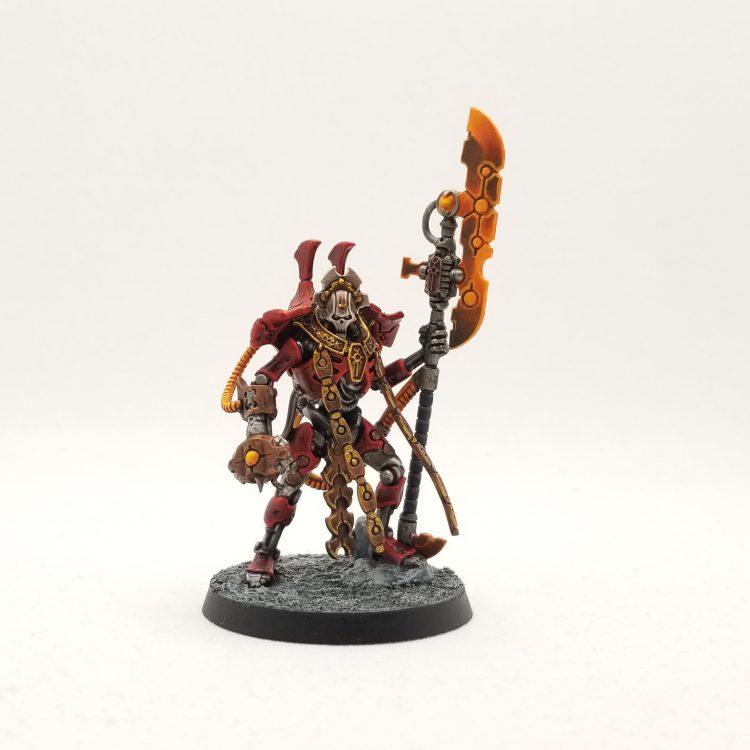
OK so the helpful thing starting off here is that, for any kind of key unit, you can’t actually go wrong with a vanilla Overlord. They’re reasonably dangerous in combat and tough enough that they’re not getting sniped out unless your opponent is on a heavy Precision plan, and remain an actual chore to deal with after their bodyguard dies, but the real draw is that they carry a Resurrection Orb and have the 10th-standard “one free Stratagem per battle round” ability. Only one Overlord can use this each turn, but it basically means you always want one with your nastiest core brick – did you read the Necron strats? Actually on that point they do bring one last cool thing – their Leadership of 4+ is one of the best in the game, so they’re not going to get Battle-shocked very often, keeping those Stratagems live. Really good stuff. Liam: Apparently this Leadership value was so good that GW changed it in the public cards to a 6+, which is much more pedestrian. It’s nice to be kept informed.

There then follows a heady list of alternative NOBLE leaders, some of which you might want, some of which you probably won’t, cost depending. Notably, none of them bring the free Stratagem, so you’re very likely putting the basic Overlord in first. A brief rundown:
- Imotekh gives you an extra CP each turn and has decent shooting and melee, plus a once-per-game Mortal AoE. He doesn’t buff his unit at all though, which feels like it might pull counter to what the army is trying to do.
- Anrakyr can only join Immortals, but gives them the powerful ability of +1 to wound all the time, plus can shut down a nearby Vehicle in your opponent’s shooting phase, giving them either -1 to hit if they pass a Battle-shock, or stopping them shooting at all if they fail. If Knights end up as a major meta force this could actually be a package you want – Immortals will often have full Wound re-rolls, so this can do a surprising amount of chip damage.
- Trazyn provides sticky objectives for the unit he leads, and has his signature trick of taking over other INFANTRY CHARACTERs when he dies, replacing them. That’s pretty neat, but the tradeoff is that his offence is garbage. It does feel like you’re going to have lots of Crypteks kicking around though, so there might be some play here.
- Zandrekh gives a random one of three buffs in each of your Command Phases, with the juicy high-roll being Devastating Wounds on a roll of 5-6. That can cause some nightmare swings in your favour, but the catch is that one of his three abilities is usually dead on the shooting of unit’s he can join. Helpfully he has a second effect of bringing a once-per-game cost increase for an enemy Stratagem, which is just generically great to have. This guy feels pretty plausible depending on where his price lands, keep an eye on him as an option.
- Obyron can tag-team with Zandrekh, and provides Fight First for the attached unit. Fight First is super good in 10th, but my vibe is that it isn’t quite needed on any of the units you can join, and you’d rather have a durability buff.
- Vanilla Lords provide +1” movement and the ability to still use Stratagems while Battle-shocked. Bringing a Resurrection Orb along means they might have some play if they’re cheap and you’ve already got an Overlord elsewhere.
- Royal Wardens are kind of honorary Nobles because they’re still compatible with Crypteks, and they honestly look great – good shooting, adds Assault/Heavy to the guns of the unit they’re leading (which notably Gauss Reapers don’t have built-in any more), and can just automatically fix Battle-shock on a nearby unit once per game. I hope he’s priced well, mine’s been on the shelf since Indomitus.
Definitely some plausible options to play with there, so who are you tag-teaming them with? You’ve functionally got five distinct Crypteks to choose from, the four regular ones and Orikan. Three of these are broadly defensive, two are focused on messing with the enemy. Let’s get the sad bit out of the way first – the Psychomancer is kind of bad. They get to try and Battle-shock something in your shooting phase and bring a small Ld debuff, but that’s basically never worth your slot over the other choices here. Battle-shocking something in shooting is pretty narrow – it’s not bad but they’ve already had a chance to Overwatch earlier in the turn if they want to, so you’re past one of the key points. Honestly this would need to auto matically shock something to be seriously worth taking, and even then it would be marginal.
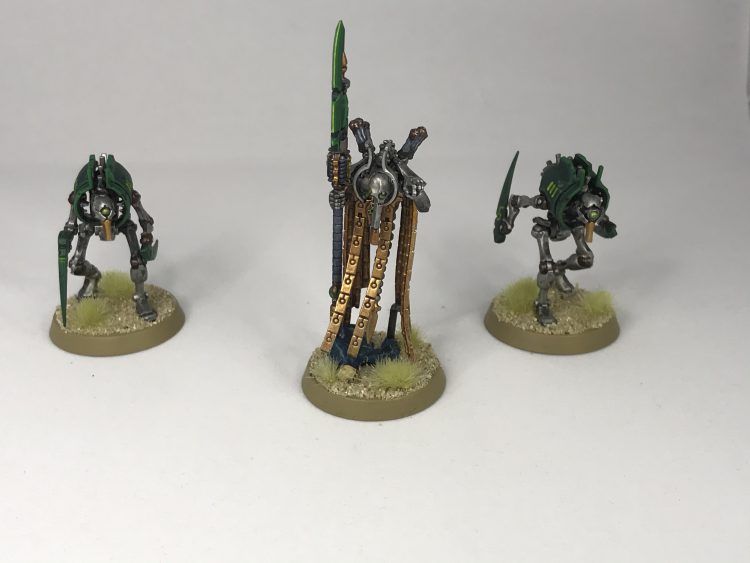
More favourable of the aggressive options is the Plasmancer, who provides a chance to do some mortals against enemies, and gives Critical Hits on a 5+ to the unit they lead. Their own shooting is also pretty decent, and this opens up a very specific setup – the Plasmancer is extremely good with Tesla Immortals, turning either a unit of five into something that will actually land a punch, or ten into a horde-clearing nightmare. Because the Plasmancer inherits the unit abilities of what they join, they also get to leverage the Wound re-rolls that Immortals get when doing this, making this a genuinely powerful thing to chuck in strat reserves or as a second wave.
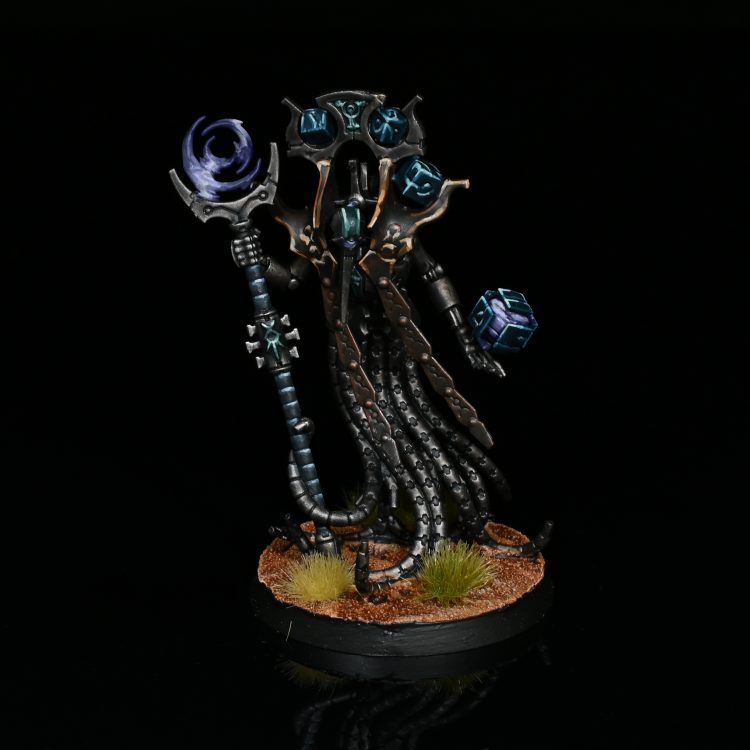
The real power here is the defensive Crypteks though, all three of which are very strong and likely to be staples of many lists. The Technomancer pairs extremely well with Lychguard – they provide a 5+ Feel No Pain to the unit they’re leading, which is super strong on 2W models. More subtly, they also help with mobility – you can take a Canoptek Cloak on one, which gives them Lone Operative if they fly solo, but doesn’t stop them joining a unit. Having a model with a 10” Fly speed that you can project out in whatever direction you’re planning to charge is massive – the base is quite big, so it can legitimately offer you 3” of extra reach that your opponent won’t see coming. A 5+ Feel No Pain is obviously great in general too, so good on Warriors.
Next up for the vanilla options is the Chronomancer. Tragically, these have lost the choice of weapons, and now only get the Aeonstave, so no more random dark lance shot. This is, obviously, tragic, but they still bring plenty to the table. While they’re leading a unit, opponents are at -1 to hit them, which is very good against armies that aren’t Marines, and after you shoot you also get a Fire and Fade style move, shifting up to 5” as long as you’re not already in Engagement Range. The Chronomancer tag-teams very well with a Royal Warden, as the latter gives guns Assault, meaning you can Advance, shoot, then get a bit of extra movement in. This can really help more sluggish units like big Warrior bricks get into the mix.
Finally, Orikan, who rules. Nothing complicated here – they just provide a 4+ invulnerable save to their unit, which is extremely impressive, and great on Warriors or scythe Lychguard. They also have a very potent combat trick, keying off the fact that their Staff of Tomorrow has Devastating Wounds. Once per game, The Stars are Right triples their attacks and strength, giving them 6A at S12, and means that all wounds they inflict are Critical. Against anything less than T12, that means you’re legitimately expecting to dump 8-10 Mortals on something, which is quite the think as a once-per-game spike from a buff Character. Expect the standard rush to buy the resin kit, followed by a bunch of varyingly faithful kitbashes once those run out.
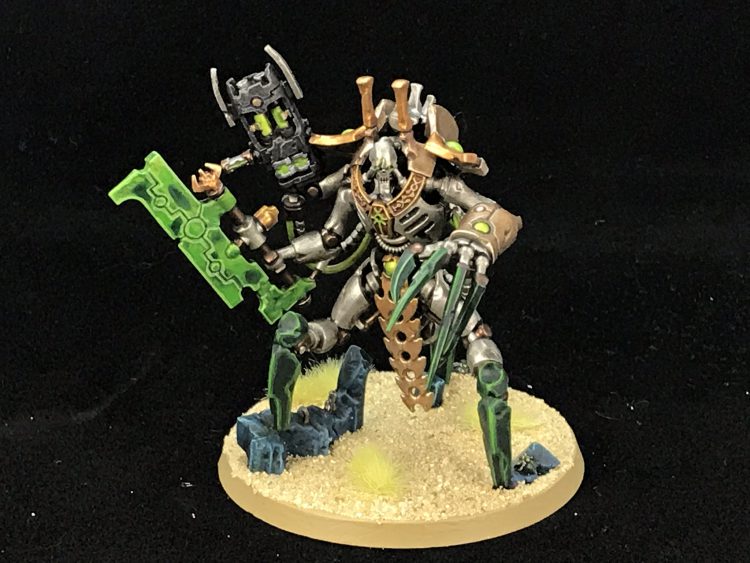
Are we done? We are not. Lokhust and Skorpekh Destroyers both have a Lord that can join them, and surprisingly/depressingly (give the Skorph has also been on Wings’ shelf all of 9th) the Lokhust is the more serious contender here. They’re reasonably tough, bring a Resurrection Orb to the party, and provide their unit with Critical Hits on a 5+, which is ultra-great on Lethal Hitting gauss cannons now they’ve been demoted to S5. They are also an important carrier for Enhancements to make that unit really sing, especially the Veil of Darkness. Looking surprisingly like a staple, so pro-tip from me (Wings) – you can trivially convert one with a Lokhust and parts from the Lychguard/Triarch kit. You’ll be seeing mine in Tacoma.
The Skorpekh Lord is slightly nastier in terms of personal killing power, but a bit less mandatory to make their unit excel. They do add Lethal Hits, which is a strong effect, plus Mortals on the charge, but our strong vibe is that Necrons are very much a synergy army, so the Skorpekh might fall behind.
Three to go. So nearly there. OK. Also all of the remaining ones absolutely whip.
First up we have Catacomb Command Barges, which have some neat tools. They’re monstrously tough if you add the Sempiternal Weave (with a 4+ invulnerable save and semi-transhuman as well), provide an aura that buffs Objective Control, and can take a Resurrection Orb to trigger Reanimation for one nearby unit in the opponent’s Command Phase. With the weave they’re just a very good all-rounder that can play on a flank mostly alone, and helps out the rest of the army if that’s your priority instead.

Next, and contender for most improved unit across…OK this is on the last day of reveals so we can say the entire game is the Hexmark. What a guy. First up, a Lone Operative, so tricky to shoot at a distance, and this edition they’ve remembered that their guns need some AP to actually do anything – they still get 6 shots, but now at -1 with Precision, which makes them genuinely scary to the buff characters of some armies. At baseline. Hoo boy does it get better. OK so first up they Deep Strike – good, strong, we like that. Next, they get to Overwatch for free once per turn, and hit on 2s when doing so. Very nice, definite problem causing, love it. Then, the final part of the recipe – Multi-Threat Eliminator. Every time an enemy unit shoots a friendly Necron unit within 3”, the Hexmark gets to shoot afterwards. Does it have to target the unit that shot? No. Are there limits on how many times it can do this? Also no. Does it still have Precision while doing so? You bet. The play with this guy is to put them in deep strike, wait till your opponent moves their forces to alpha one of your big bricks, then Rapid Insertion them so they’re within 3” of the unit your opponent has designs on, and 12.1” away from any of their stuff. Once you’ve done that? Well, if there are any enemy units within 18” they are going to pay for trying to grind down your key unit. A++, top marks.
…a statement that also applies to Illuminor Szeras, who finally has rules to do justice to their awesome new kit. They’re a Lone Operative as long as they’re within 3” of a friendly unit, have a great aura for buffing Warriors and Immortals (+1 to their AP, -1 to incoming AP), strong damage output and are brutally tough to kill. They’re T8, 9W with a 4+ invulnerable save and a 4+ Feel No Pain and the first time they die you can get them back up on 5W with Protocol of the Eternal Guardian. They are legitimately “face tank half an army” tough, and still add tonnes of value before they’re doing that – what’s not to love?
C’tan
OK yes, technically they’re Characters, but they get their own section. C’tan get a shakeup from 9th – no more phase caps and Mortal tricks, instead just an absolutely nails defensive profile, powerful shooting attacks for their Powers and better melee across the board. All flavours are T11 with a 4+ invulnerable save, 12W and halving damage, which is very much up there as defensive profiles go, and all the named ones have Reanimation Protocols, so gradually heal.
In terms of what they do? The Nightbringer is still the all-purpose killing machine of the bunch, augmented from 9th with a massive boost to their sweep attack, which now gets 14A and crucially does D2. Their shooting also provides nasty spike potential, and they unleash a big AoE Mortal Wound effect at the end of every Fight Phase, which can be great in some matchups.
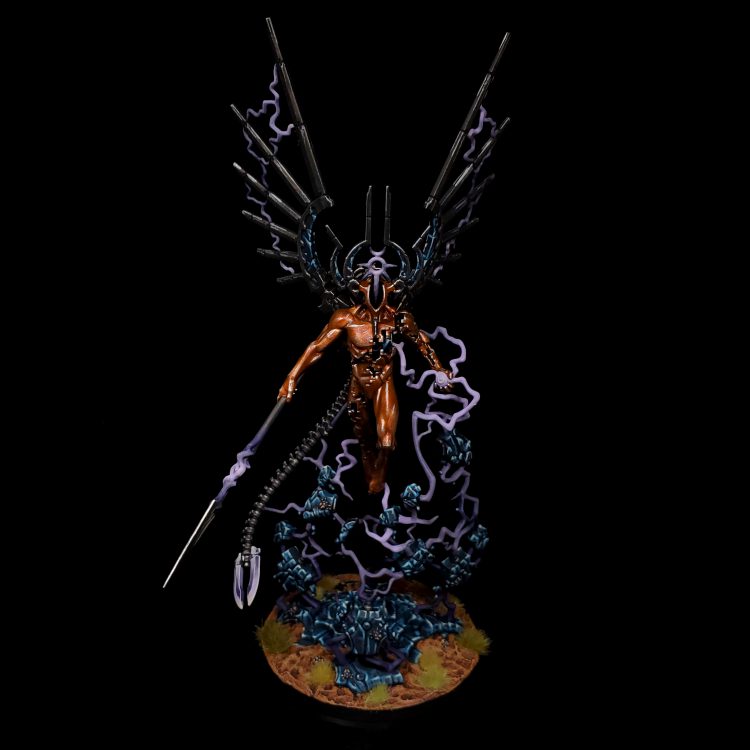
The Void Dragon is another killer, albeit more specialized – their spear is Anti-Vehicle 2+ and hits like a truck, but they’re a bit less terrifying into everything else. Not un-terrifying mind – their sweep has also gone to D2, so they can take apart Space Marines handily, and their Voltaic Storm shooting attack is just a great all-rounder profile.
The Deceiver also wins big from the general uprating of melee, now throwing out 8A at S8 AP-3, which is still not as scary as what you can do with the others, but no longer falls flat against elite infantry, which is a good change for them. They’re also the hardest to shoot off thanks to Stealth, give you a free redeploy of three units after both sides are set up (including pulling to Strategic Reserves), and have a very swingy Precision Anti-Character Devastating Wounds shooting attack that’ll give opponents fits. Very cool.
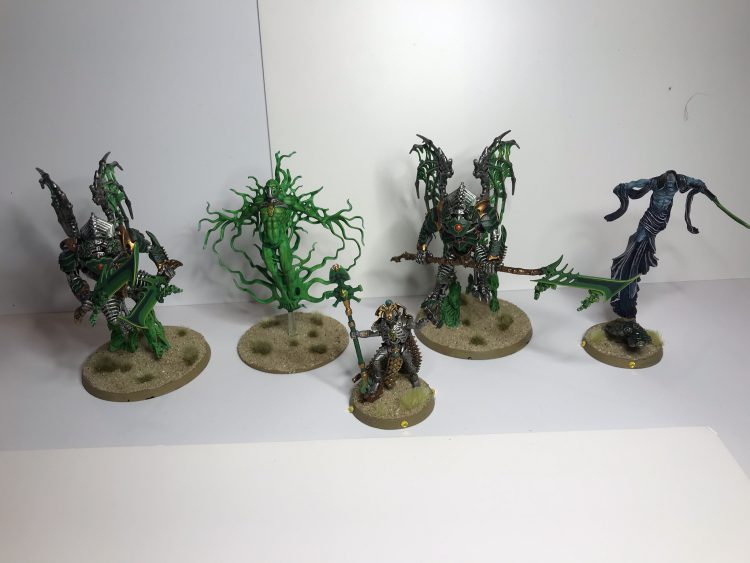
Last up, the only non-Epic Hero of the bunch is the Transcendant, who doesn’t get Reanimation but can, as pointed out earlier, currently take the Sempiternal Weave. For your health, we recommend not doing the maths about what it takes to kill one with that. Don’t worry about it. In terms of what they do other than that, they’re pretty cool – nasty shooting and melee, but more crucially they get to redeploy on board any time they advance, making them potent board control tools (especially considering how tough they can be). We think the named ones probably get the edge, but there’s at least a draw here.
Battleline

Necron Warriors
The backbone of the Necron Legions, the humble and nearly unending Necron Warriors, continue doing their job as the Bop Bags of the Necron army. As shown on the Warcom website, they have the special rule Their Number is Legion. This states that each time the units’ Reanimation Protocols activate reanimate d6 wounds instead of d3, unless it is within range of an objective marker you control, where you will reanimate 3+d3 wounds instead. Your hordes of Necron warriors will start at 10 and can go up to 20, and they are armed with Gauss flayers or Gauss reapers. Flayers fulfill their same rapid-fire job they have been doing since their inception. Rapid Fire 1 and Lethal Hits provide some okay fire output. The real issue here being that they are only S4, AP 0 and a single damage. I don’t know what you’ll want to kill with these, but they will make people take some saves.
The gauss reaper Necron warriors some much needed firepower with two shots at 12 inches at strength 5, AP1 and damage one. Like all gauss weapons, it also has lethal hits. Though the weapon is a short range, it does allow for Necron warriors to begin to participate in the shooting phase. When led by a unit with command protocols, both weapons have a ballistic skill of four, which will be a 3 with the +1 to hit. Not too shabby when we are looking to combo this unit with the Illuminator or even just a Plasmancer for the Critical hits on 5’s to make those lethal hits really land.
Immortals
These spent most of 9th Edition being a bit of a tax that you didn’t love having to include, but took anywhere. Going into 10th it looks like there’s a genuine plausible place for them thanks almost entirely to the Plasmancer. Critical Hits on 5s with tesla weapons takes us back to the glory days of comboing it with My Will Be Done in 8th, and lets you unleash a truly shocking amount of hits from the squad. Those hits will also very frequently convert into wounds – they get RR1s all the time, and full re-rolls against a target that’s in range of an objective. Unless they’re way too expensive (which, you know, Necrons so always possible) this ends up meaning there’s a variety of different ways you can use them – small squads can reliably put the hurt on their counterparts in other factions, while full units with a Plasmancer can put so many saves into stuff that the lack of AP doesn’t matter.
Other Robots
Cryptothralls

Cryptothralls are the protective big brothers of our Crypteks. They can join a unit as a Cryptek Retinue. At the start of the declare battle formations step, the Cryptothralls can join one other unit from that army that is being led by a Cryptek infantry model. If you decide to do this until the end of the battle, every model in this unit counts as being part of that original bodyguard unit, and the bodyguard unit’s starting strength is increased accordingly. What this means essentially, is the Cryptothralls are now bullet catchers for the unit, and boy what amazing bullet catchers are they. They are now T4 with two wounds, a 3+ save, and a 4+ feel no pain. What this does is provide your unit with some guys who are able to catch mortal wounds, as well as if they are part of the same unit as a Cryptek model, they also give that model a 4+ feel no pain as well. This helps protect your Plasmancer from those pesky snipers floating around. They are alright in close combat, but their main use will be to soak up as much as possible and then to reanimate, so they can do it all over again.
Wings: I cannot stress enough how absurdly good these are from test games. If you’re going Infantry-heavy, three units in every list. They even provide flexibility in how you set up your army – while creating bumper-sized tarpits is their main role, if you feel you need an extra objective holder in a given game you can just choose not to attach one of the squads you’ve brought along.
Deathmarks
Death marks have gone from being a partially useless unit, to being something of a scary powerhouse of snipers. These sniper teams can be brought in blocks of 10, and their guns have received a bit of a glow up. They are Ranged 36, with heavy and precision at Ballistic Skill 3, Strength 5, -2AP, 2D. This is a great profile as it can threaten most characters and bring them to their invulnerable saves. Their special rule, paper, space hunters, means that once per turn in the reinforcement step of your opponent’s movement phase, when an enemy unit is set up in the battlefield 18 inches away and they are visible, this unit can then shoot them as though it was their shooting phase. There’s going to be a lot of deep-strikers in this game, a lot of out-of -phase deployments, and having a unit or two of these in our backfield is going to prove to be incredibly useful.
Flayed Ones
The humble flayed ones make a nice reappearance into our index, being one of our primary infiltrator units that can be taken in units of 5 to 10. They come with the stealth special rule, as well as a nice handful of close combat attacks. Flayed Ones have four attacks apiece with Sustained Hits 1 and Twin Linked. They are only strength 4,-1 AP, 1D so don’t expect them to pick up some tanks. They’ll put the hurt on some Guardsmen equivalent or some Space Marines. Run them in the full squad of 10 so you get your 40 attacks, and you’ll see their Flesh Hunger rule in full action. Whenever they make an attack that targets a unit that is below half strength, every successful hit role is a critical hit. So, if you bring a Space Marine unit from 10 to 5, suddenly every single attack you do will explode. It’s a very cool unit, definitely made with finishing off other infantry units in mind, and I think we can definitely see them in the table performing some infiltrated harassing.
Lychguard
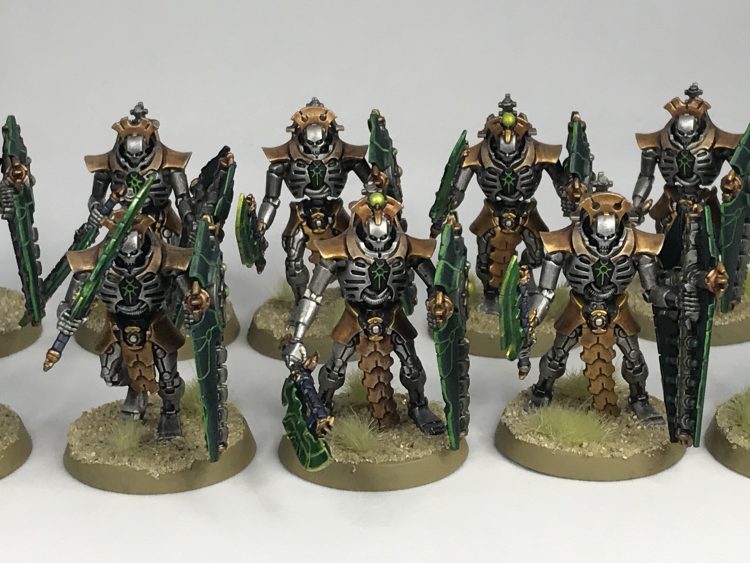
Lychguard will continue to fulfill the role they have always done protecting our main characters. While a Noble is leading this unit, their special rule called Guardian Protocols is activated. With this ability, they will always be -1 to be always wounded from shooting or close combat attacks. An incredible ability for a very durable unit. Lychguard provided us with two different ways to use them. One way being with Dispersion Shields and hyper phase swords, providing the unit with a 4+ invulnerable save and 3 attacks at S6, -2, 1D. The other way being our prized Warscythes. These are incredibly nasty, sitting at S8, -3, 2D along with Devastating Wounds. Unfortunately, they only have 2 attacks so we can’t expect them to get too crazy by themselves, but luckily we have some amazing characters that can join this unit. Look at leaders like Orikan the Diviner to hand out a 4++ to your Warscythesunit.
Triarch Praetorians
Flying all-rounders with fancy sticks, though it’s fair to say that the pistol option is a little bit more appealing, as it now has Devastating Wounds. They can also Deep Strike and Fall Back/Charge, so there is quite a lot going on, but the killer with these has always been that they don’t synergise well with the rest of the army, and this time around that’s in full evidence as no Leaders can join them.
Skorpekh Destroyers

Big spicy boys. Pretty scary, durable thanks to T6 and able to ignore modifiers to their stats when fighting in melee, which can be clutch against some armies. Also get to take one plasmacyte token per three for a once-per-game shot of Devastating Wounds, which can create big swing turns.
Ophydian Destroyers
Faster, sneakier versions of the above, at a cost of being slightly squishier and lower S. The squishiness differential is actually notably down from 9th, because with all Destroyers jumping up a point of Toughness these have gone to T5, stopping them being so easily mown down by small arms. More challenging is the S4, but they do still get the turn(s) of Devastating Wounds and a good number of attacks, and can redeploy as long as they end the opponent’s Fight Phase not in Engagement Range. One unit of these as a home objective holder that can sometimes head out and do utility/murder stuff seems plausible.
Lokhust Destroyers

These are super tricky to evaluate, and more than any other unit here we really need the points to see their worth. On the good side, there’s great synergy support for them from the Lokhust Lord and the stratagems, and going to T6 makes them pretty painful to shift (especially as lots of Marine melee is now S5). On the downside, they’re now FLY MOUNTED and only have 7” move, so the unit can be a pain to maneuvre, and their guns got a bit weaker, going to S5 and AP-2. On some level the S is academic, because you’re going to be running these with a lord for Lethal Hits on a 5+, which does make them a very versatile engine of destruction, so you probably will see these.
Lokhust Heavy Destroyers
Speaking of engines of destruction – a lot of anti-tank guns have been toned down a bit from 9th, but the gauss destructor is not one of them, striking at S14 AP-4 and flat damage 6, with built in wound re-rolls of 1 against VEHICLE and MONSTER targets. This owns, but the bigger surprise is that the other gun is seriously worth considering this time around, switching the unit to an anti-infantry role. It’s now six shots with rapid fire six and Sustained Hits 1, so if you stick a Lokhust Lord with a squad and open up on something within Rapid Fire Range you’re looking at 42 hits on average, and in this mode you get re-roll 1s to wound into INFANTRY. Both versions look fantastic, and are another unit that loves +1T.
Tomb Blades
Speedy objective grabbers, with a side order of occasional shooting spikes with particle beamers, which now have Devastating Wounds. These Scout 9” which is very handy, and they’re pretty tough if you put the Bladevanes and Shadowlooms on them, so should remain a staple utility piece.
Canoptek Cornucopia
Canoptek Wraiths

Wraiths finally just FLY, though are still BEASTS so can wallhack with Infantry all day long. They’re looking like decent all-rounders, particularly as right now they have what is probably a copy-paste error on one of their gun profiles, hitting on 2s (I say copy-paste because the other place the gun appears is Triarch Praetorians). They’re relatively speedy, hard to shift with T6 3W and a 4+ invulnerable save, and throw out a decent amount of D2 attacks in melee, though their S6 isn’t what it used to be and they have relatively poor WS and AP.
Canoptek Scarab Swarms
Someone at GW was clearly low-key mad at how often cheap Swarms were used as objective holders in the last few editions, as Scarabs join many other examples in having OC0. That makes them a pretty tough sell, but not out of the question – they have a lot of attacks with Lethal Hits, and can also take a decent chunk out of something with their signature self-destruction. They also reduce the OC of enemies in Engagement Range, albeit to a minimum of 1, so it’s only really good for tilting the balance against squishy enemy Battleline units.
Canoptek Reanimator

We already waxed lyrical about this in the Reanimation section. Take one. Give a C’tan 6 wounds back when you roll two threes. Watch the light die in your opponent’s eyes. Oh also, it has a 4+ Feel No Pain, so it isn’t even trivial to snipe out. Your opponent will also enjoy discovering this.
Canoptek Spyders
A great backfield babysitter, and also provides clutch protection against the Psychic Attacks that some armies can throw – a big 4+ Feel No Pain aura against them.
Canoptek Doomstalker
Never quite got there in 9th, will things be different this time? You have no idea how desperate Necron players are for these to be good. The auspices definitely look more positive this time around – their gun’s quality is no longer tied to being stationary, just always hitting for flat three damage (at very high stats, which is good) and they have a 4+ invulnerable save, which you’re obviously not going to say no to. They also overwatch on 5+, which can certainly upset some things. The only drawbacks are the low BS of 4+ (so you definitely need to commit to either a Canoptek Control Node or the Sovereign Coronal) and relatively low T8, though at least that still pushes them out of small arms range. Maybe, maybe.
Small Vehicles

The Necron’s small and medium vehicles mostly fall into similar buckets as they did before, though some are considerably better at their jobs. In terms of “about the same” the main ones are the Triarch Stalker and the Night Scythe. The Stalker still boosts your army into whatever it hits, and is slightly less embarrassing in a melee fight, while the Scythe is still a flying transport that has a new trick letting it pick up an unengaged unit at the end of the Fight Phase. There could be some neat tricks to pull with that, perhaps picking up some Deathmarks after they shoot, but it has the critical problem of being an Aircraft Transport without Hover, so can’t start doing stuff till T2. It is at least not a Dedicated Transport, so you have the option of starting it off the board without anything inside, then bringing it on turn 2 to pick up a shooting unit after they’ve done some work. Also plausible with tesla Immortal units.
Moving on to the “considerably better” category we have all the shooty hulls. The Doomsday got previewed on WarCom, and is absolutely hilarious – Devastating Wounds on a gun that big is definitely an appropriate reward for staying still. The Doom Scythe is also very nasty, with three very potent shots on its big gun with Sustained Hits d3. Big upward spike potential, fine on rate, good to see. Finally, biggest winner of the lot is the Annihilation Barge, which I am currently trying to decide if I can face painting. Not only is the big gun now D2 and twin-linked (something you’re more than happy to lose some shots for), it has the Malevolent Arcing special ability, which means that when you target an enemy, before resolving the attacks you roll for each enemy unit (including the target) within 3” of them and deal d3 Mortals on a 5+. Three of these focusing something can thus cause big problems for opposing battle piles, and way more of these should make it into lists.
Finally, Ghost Arks. Great ability, unclear if what it carries is worth it, and as a Dedicated Transport you have to bring someone to ride. The ability is that once per turn you can trigger the same effect as the Protocols of the Undying Legions stratagem on a nearby Necron Warriors unit, which is very good. However, 10 Necron Warriors with one Character (which is what it carries) might be a challenging sell (no room for Cryptothralls, boo), so we’ll have to see what the cost looks like.
Big Vehicles
Nearly there – three large boxes of various stripes, and the Silent King himself overseeing it all.
The Obelisk, voted 8th Edition’s worst unit by the community, is still garbage. With every rewrite that passes, it seems more and more plausible that this is being done on purpose as a bit.
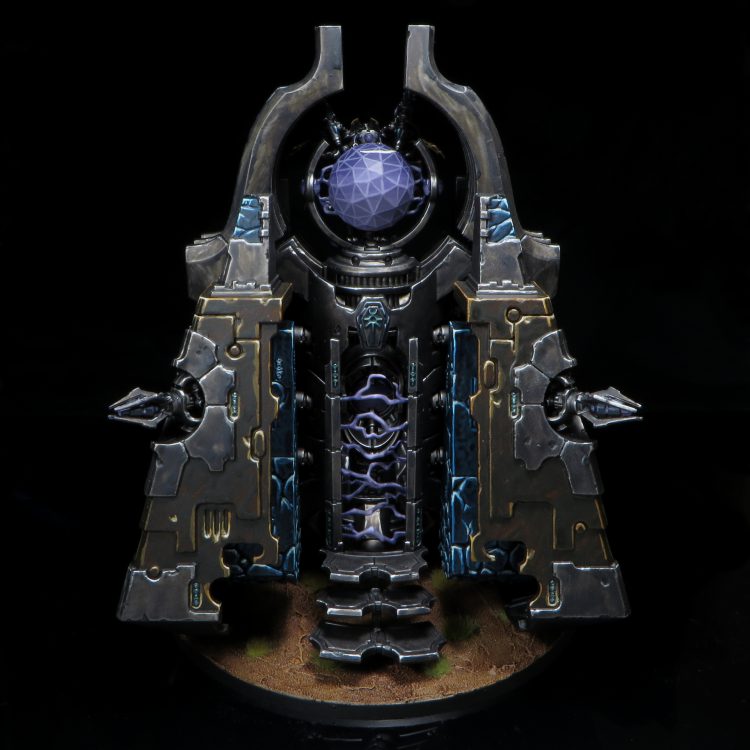
The Monolith, on the other hand, is looking considerably more interesting this time around, in significant part because of its spectacular T14, which I think is the joint highest across all Indexes (and I am not going back to check). The going rate for a “serious” anti-tank weapon in 10th is S12, and even some of the very hefty ones like the Gauss Destructor “only” hit S14. It’s also spectacularly nasty on the offence (with the death ray build), has a 2+ save that it can often augment with Cover, and can both Deep Strike and teleport a unit around each turn (at a cost of them being able to charge). A single Monolith turned up in quite a few late-stage 9th Edition lists, and I think there’s a pretty good shot of that being repeated. It’s also TOWERING, which is a distinct upside for it (given how tough it is) as it can unload death rays and particle whips into enemy tanks and monsters that are skulking behind ruins.
The Tesseract Vault is also looking good, and hilarious. It’s still incredibly impractical to use on the tabletop, but the power is there – it’s ridiculously tough at T12 2+/4+ invulnerable, has good anti-infantry shooting from its tesla orbs, and gets to select one of three spicy Devastating Wounds shooting attacks to use each turn – the funniest of which is definitely Time’s Arrow, which is Precision Anti-Character 4+, Devastating and flat damage 6. Put it like this – someone somewhere is going to try one.

Finally, Szarekh – surprisingly one of the least changed datasheets stat wise, though the sheer number of abilities he used to have has been cut down and consolidated. He now picks one of three Auras per turn – RR1s to hit and wound in shooting, re-roll charges, or immunity to modifiers (except on armour saves). It feels like this Index is pulling Necrons back towards shooting, so the first of these should prove pretty valuable, and having the King’s damage output available for the mid game is still great. The only thing to watch out for is that the changes to FLY make it harder to jump him into the right position when it’s go time, so make sure you’re planning how he’s navigating the table.
Five Coolest Units
Good grief, this army has a lot of units. Anyway:
- The Hexmark Destroyer: Yes, haha YES.
- Illuminor Szeras: Absolute beast of an all-rounder
- C’tan: All of them look like great fun to use, and it’s fantastic to see them pick up a statline to mirror their fluff rather than the weird phase cap of the previous edition.
- Lokhust Heavy Destroyers: Being so aggressively good at their job is very endearing.
- Cryptothralls: The little trashcan velociraptors that could. Seriously Play some games with them. They are astounding.
Five Biggest changes from 9th
- Shooting is your go-to for damage: Melee stocks generally down, gun stocks are up.
- Every Character has a purpose: OK, except the Psychomancer – but almost everything else does something cool enough that you consider them.
- Brick durability high: Stacking up a defensive Cryptek, Cryptothralls and a nearby Reanimator on a big Warrior or Lychguard unit pushes the lift for the opponent to clear them out sky high once Undying Legions is factored in. Warriors are maybe on a par with what you could do with them in 9th, Lychguard massively tougher.
- No more ObSecrons: You can’t just win on objective technicalities any more.
- Mobility is lower: The one sad point – everything is just that little bit slower, so you need to be careful to either plan ahead or include buffs to counter it.
Wrap Up
We’ve been buzzing about Necrons since getting access to these rules – they’re extremely exciting, the army has a tonne of depth to play with when building lists, and it now feels viable to pull it in several directions. In addition, some units that never really got their moment in previous editions now look not just good but great, and as long as (metal fingers crossed) the points don’t ruin it, Necrons look like they’re going to be massive fun. It’s also worth, as a late note, that one of our key reservations with them was that a lot of possible builds just auto-lost to Deathwatch Devastating Wounds lists, so Games Workshop putting a much-needed stop to that makes us even more hyped (as you can tell by the fact that this may accidentally have evolved into the longest of these reviews).
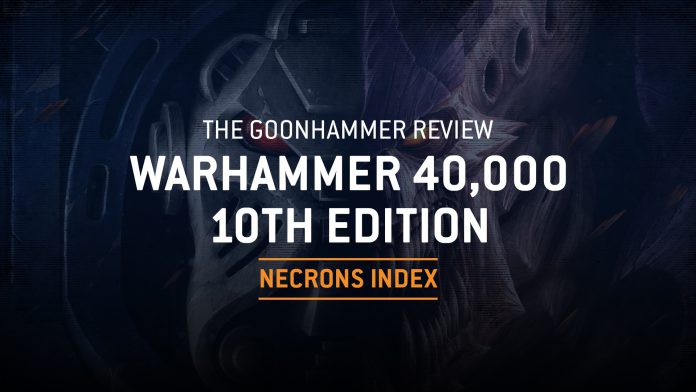


You must be logged in to post a comment.